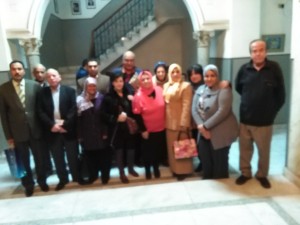After graduating from Al-Hussien High School in Amman, Dr. Hammoudeh obtained his MD degree from the Jordan University School of Medicine, Amman, Jordan in 1986 and did his internship and 2 years in the Internal Medicine residency program at the Jordan University Hospital from 1986-1989.
In 1989, he joined the Internal Medicine Residency Program at St. Michael’s Medical Center (Seton Hall University School of Graduate Medical Education), New Jersey, USA. He got the American Board of Internal Medicine in 1992. He finished his cardiology and interventional cardiology fellowships at the same Medical Center and was awarded the American Board of Cardiovascular Disease in 1996 and the Interventional Cardiology Certificate from Seton Hall University in 1997. He was appointed as a Clinical Instructor at Seton Hall University School of Graduate Medical after his graduation.
In late 1997, Dr. Hammoudeh returned to Jordan and worked as an intervantional cardiologist at the Islamic Hospital (until 2001) and at Al Essra Hospital (until 2008). He is currently an interventional cardiologist at the Cardiovascular Consulting Group/Istishari Hospital, Amman. Dr. Hammoudeh is a fellow of the American College of Cardiology since 1998. He is a member of the European Association of Percutaneous Cardiovascular Interventions (EAPCI), the Society of Medical Graduates of American Universities and Hospitals, Jordan Cardiac Society, and Jordan Atherosclerosis and Hypertension Society, Amman.
Dr. Hammoudeh was involved in research in the States in nuclear cardiology, myocardial viability studies and coronary plaque rupture at St. Michael’s Medical Center and St. Joseph’s Hospital and Medical Center, NJ. In Jordan, he headed several investigation groups (Jordan hyperlipidemia, JoHATRS, and Jordan Collaborating Cardiology Groups, JCC, and SMART registry) that have undertaken major projects in dyslipidemia (JoHARTS Study, coronary risk fatcors, low HDL, diabetes, CRP and prognosis in ACS (CAPRIS study), STEMI triggers and reperfusion strategies (MINTOR study), adherance to ACS guidelines, glucometabolic states in ACS (GLORY study), and gender dispariehts in ACS therapy. He was an investigator in several international studies as well (Multicenter International Diabetes– Acute Coronary Syndromes (MIDAS) Registry, ACTION study of stroke risk in hypertensive individuals in the Middle Ease, and the Acute Cornary Syndrome (ACCESS) Reigstery). He heads the National R3i (Residual Risk Reduction Initiative) Committee which works under the International R3i Committee to promote CV risk beyond the classical risk factors control. He also headed the steering committee for the REALITY study the looked at the LDL target reaching in dyslipidemic patients, and was also a participant of the ULTIMATE registry that evaluated direct renin inhibitor in hypertensive patients in Jordan.
He served and is still serving in many academic and sceintific bodies including Jordan Medical Board- Committee on Cardiovascualr Diseases, Head of scienetific committee of the Jordan Atherosclerosis and Hypertension Society, Member of the Editorial Boards of The Lancet-Middle East, Pan Arab Medical Journal, and past Editor of “Bulletin” of the Jordan Lipid and Hypertension Society” and “Menopause Update” of the Jordan Menopause Society, and pan Arab Angiology Journal, and World Cardiology Journal.
He was awarded several awards at the American College of Physicians-NJ Chapter Scientific Conference 1997, and Research Colloquium of the Seton Hall University School of Graduate Medical Education, South Orange, NJ, for 3 consecutive years.
He presented lectures, symposia, and research studies at the European Society of Cardiolgy Annual Meetings, American Federation of Clinical Research, The World Hypertension League Meeting, International Conference of the Jordan Cardiac Society, Pan Arab Congress of Diabetes and Endocrinology, Jordan Menopause Society Conference, Jordanian Medical Conference, Regional Meeting on Prevention of CHD and Stroke (International Task Force for Prevention of Coronary Heart Disease), International Conference of the Jordan Atherosclerosis and Hypertension Society, Joint Jordanian American Endocrine Congress, and Second Congress of the Jordanian Society of Endocrinology, Diabetes and Metabolism, Middle East/Africa ACS Workshops, and the World Congress of Cardiology.
Dr. Hammoudeh published many articles in the American Heart Journal, Clinical Research, New England Journal of Medicine, Catheterization and Cardiovascular Diagnosis, Journal of Thoracic and Cardiovascular Surgery, Journal of Investigative Medicine, Hospital Medicine, Contemporary Internal Medicine, American Journal of Geriatric Cardiology, Clinical Cardiology, Jordan Medical Journal, Clinical Diabetes-Middle East, Pan Arab Medical Journal, Middle Eastern Journal of Emergency Medicine, Lebanese Medical Journal, International Journal of Cardiology, International Journal of Atherosclerosis, European Heart Journal, Cardiology in Review, and Eastern Mediterranean Health Journal.
Lest we forget… Beit Dajan-Jaffa
(لكي لا ننسى بيت دجن يافا) is a 385-page book about Beit Dajan,a 1948 palestian village ethnically cleansed on April 25, 1948 by Zionist terrorists. Nine km east of Yaffa, this 5500- inhabitant village was the home of the most famous orange groves, traditional Dajan Palestinian embroidered dress (thobe) and a Crusade castle. In this book Hammoudeh details the village’s history from as far back as the time of the Canaanites to the years before the Nakbeh in 1948 and how its residents were driven out after the creation of Israel on Palestinian lands. The village’s name comes from the Canaanite god Dagon, according to Hammoudeh. He has interviewed 60 men and women born in Beit Dajan in 1920s, 30, and 40s, who currently live in Amman, Jordan who rewinded their memory engines about all social, economic, educational, political, and Nakba details. The map of the village was redrawn as it was in 1946, making it the first complete and detailed map of a 1948 Palestinian village.




